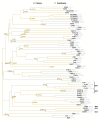Interplay Between CMGC Kinases Targeting SR Proteins and Viral Replication: Splicing and Beyond
- PMID: 33854493
- PMCID: PMC8040976
- DOI: 10.3389/fmicb.2021.658721
Interplay Between CMGC Kinases Targeting SR Proteins and Viral Replication: Splicing and Beyond
Abstract
Protein phosphorylation constitutes a major post-translational modification that critically regulates the half-life, intra-cellular distribution, and activity of proteins. Among the large number of kinases that compose the human kinome tree, those targeting RNA-binding proteins, in particular serine/arginine-rich (SR) proteins, play a major role in the regulation of gene expression by controlling constitutive and alternative splicing. In humans, these kinases belong to the CMGC [Cyclin-dependent kinases (CDKs), Mitogen-activated protein kinases (MAPKs), Glycogen synthase kinases (GSKs), and Cdc2-like kinases (CLKs)] group and several studies indicate that they also control viral replication via direct or indirect mechanisms. The aim of this review is to describe known and emerging activities of CMGC kinases that share the common property to phosphorylate SR proteins, as well as their interplay with different families of viruses, in order to advance toward a comprehensive knowledge of their pro- or anti-viral phenotype and better assess possible translational opportunities.
Keywords: CMGC kinases; RS domain; serine/arginine-rich proteins; splicing; viral replication.
Copyright © 2021 Pastor, Shkreta, Chabot, Durantel and Salvetti.
Conflict of interest statement
The authors declare that the research was conducted in the absence of any commercial or financial relationships that could be construed as a potential conflict of interest.
Figures





References
Publication types
LinkOut - more resources
Full Text Sources
Other Literature Sources
Research Materials
Miscellaneous

